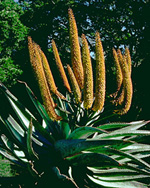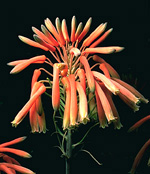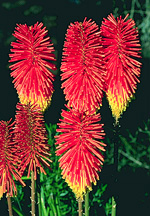 |
This small family, native to Africa (especially South Africa) and Madagascar, is represented in Australia only by a few species of naturalised Aloe, mostly found close to gardens and suburbs in eastern and southern Australia. A few other genera may be found persisting in old gardens.
Characteristic features of the family Aloaceae in Australia include: - robust herbs with large, thick, succulent, often spiny leaves from a woody, erect, short or elongate trunk
- flowers yellow, orange, pink or red, curved-tubular, in large, simple or branched racemes
- ovary superior, 3-chambered, developing into a capsule with large seeds
Description
Evergreen shrubs or perennial terrestrial herbs, perennating by rhizomes or stolons. Vegetative reproduction by rhizomes or stolons. Internal secretions of mucilage. Plants glabrous. Leaves alternate and spiral, all or mostly basal or both basal and cauline if herbs, sessile. Stipule-like lobes absent. Lamina simple, symmetric, canaliculate or filiform, acicular, subulate, linear, lanceolate or ovate; base lobed or auriculate; margins entire, serrate or spiny, ±flat; venation parallel, or not obvious, with the midrib inconspicuous, and the tertiary venation not reticulate; surfaces not punctate; leathery or succulent; distinctive odour absent or foetid. Leaf ligule absent. Plants with all the flowers bisexual. Inflorescences axillary, consisting of panicles. Bracts present. Pollination by insects or birds. Flowers odourless; stalked. Floral disc absent; nectaries absent. Perianth irregular, of 2 ±similar whorls, with 6 fused petaloid segments, 2-lipped, with a prominent palate or curved-tubular, orange or pink, streaked, spotted, etc, succulent or leathery; lobes ±entire. Fertile stamens 6, opposite to and at least partly fused to the perianth, free of the ovary and style, distinct from each other, clearly alternating long and short. Anthers dorsifixed, versatile, opening inwards by longitudinal slits; 2-celled. Ovary superior and sessile. Carpels 3, fused; ovary with 3 locules. Style terminal, single, unbranched, with the stigma conical. Ovules 1–numerous per locule, stalked; placentation axile. Fruit a dry loculicidal capsule; the perianth on the maturing fruit deciduous or dry and persistent. Disseminule macro-surface winged; micro-surface ±smooth, white, brown, grey or black, dull. Seeds numerous per fruit. Aril present or absent. Cotyledons 1. Embryo straight.
(Note: this description has been generated from the coded data compiled for the key. Any errors in the key data will be reflected in the descriptions.)
A treatment of the family Aloaceae has been published in:
Flora of Australia 46: 66-70.
Australian genera of Aloeaceae (as recognised for the Flora of Australia)
* = all species introduced
*Aloe
*Kniphofia

|
  |

Aloe ferox (habit)
Photo: M.Fagg © ANBG

Aloe saponaria (flowers)
Photo: D.Hardin © D.Hardin

Kniphofia sp. (flowers)
Photo: D.Jones © D.Jones
|
 |
|